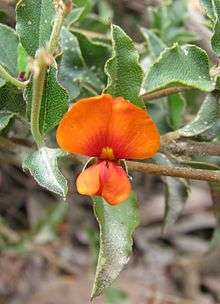Podolobium procumbens
| Podolobium procumbens | |
|---|---|
 | |
| Scientific classification | |
| Kingdom: | Plantae |
| (unranked): | Angiosperms |
| (unranked): | Eudicots |
| (unranked): | Rosids |
| Order: | Fabales |
| Family: | Fabaceae |
| Genus: | Podolobium |
| Species: | P. procumbens |
| Binomial name | |
| Podolobium procumbens (F.Muell.) F.Muell. ex Crisp & P.H.Weston[1] | |
| Synonyms | |
|
Oxylobium procumbens F.Muell. | |
Podolobium procumbens, commonly known as Trailing Shaggy-pea, Trailing Podolbium or Trailing Oxylobium, is a shrub that is native to south-eastern Australia . The species is a member of the family Fabaceae and of the genus Podolobium. It grows up to 30 centimetres high or may have a prostrate habit. The leaves are 10 to 25 mm long and 6 to 12 mm wide.[2] The orange pea-shaped flowers are produced between November and January in the species native range.[3]
The species was formally described in 1855 by botanist Ferdinand von Mueller in his paper Definitions of rare or hitherto undescribed Australian Plants, chiefly collected within the boundaries of the colony of Victoria. Mueller gave it the name Oxylobium procumbens Mueller and noted occurrences at Mount Disappointment, the Black Forest, the Goulburn Ranges, along the Delatite River and at Ballarat. The species was transferred to the genus Podolobium in 1995.[1]
It occurs in woodland in Victoria and south-eastern New South Wales.[2][2]
References
- 1 2 "Podolobium procumbens". Australian Plant Name Index (APNI), IBIS database. Centre for Plant Biodiversity Research, Australian Government, Canberra. Retrieved 2 December 2012.
- 1 2 3 "Podolobium procumbens". PlantNET - New South Wales Flora Online. Royal Botanic Gardens & Domain Trust, Sydney Australia. Retrieved 2 December 2012.
- ↑ Wild Plants of Victoria (database). Viridans Biological Databases & Department of Sustainability and Environment. 2009.